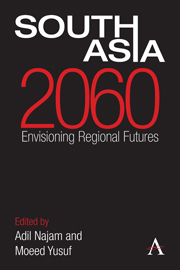Book contents
- Frontmatter
- Contents
- Acknowledgments
- List of Abbreviations
- Introduction: Imagining South Asian Futures
- Section I South Asia as a Region
- Section II State Relations
- Section III Development
- Chapter 16 South Asian Economy in 2060
- Chapter 17 Economic Futures: Challenges Ahead
- Chapter 18 South Asia in the Asian Economy: Struggling to Overcome History
- Chapter 19 Globalization and South Asia
- Chapter 20 Trade Relations: Some Predictions and Lessons
- Chapter 21 Urban Policy for Environmental Quality and Well-Being
- Chapter 22 Urban Futures, Urban Challenges
- Chapter 23 Water Security: Risks and Responses
- Chapter 24 Agriculture and Food Security
- Chapter 25 Meeting Electric Power Demand in South Asia
- Chapter 26 E-South Asia: A Social Science Fiction
- Section IV Human Well-Being
- About the Authors
- Bibliography
- Index
Chapter 16 - South Asian Economy in 2060
from Section III - Development
Published online by Cambridge University Press: 05 September 2013
- Frontmatter
- Contents
- Acknowledgments
- List of Abbreviations
- Introduction: Imagining South Asian Futures
- Section I South Asia as a Region
- Section II State Relations
- Section III Development
- Chapter 16 South Asian Economy in 2060
- Chapter 17 Economic Futures: Challenges Ahead
- Chapter 18 South Asia in the Asian Economy: Struggling to Overcome History
- Chapter 19 Globalization and South Asia
- Chapter 20 Trade Relations: Some Predictions and Lessons
- Chapter 21 Urban Policy for Environmental Quality and Well-Being
- Chapter 22 Urban Futures, Urban Challenges
- Chapter 23 Water Security: Risks and Responses
- Chapter 24 Agriculture and Food Security
- Chapter 25 Meeting Electric Power Demand in South Asia
- Chapter 26 E-South Asia: A Social Science Fiction
- Section IV Human Well-Being
- About the Authors
- Bibliography
- Index
Summary
South Asian economies have grown rapidly during the last two decades recording an average growth rate of 6 percent annually. Incidence of poverty has been reduced although the absolute number of poor has increased in the last two years because of the external shocks and internal turbulence in some countries. The private sector has been the principal driver of the economic turnaround as increased competition resulted in improved efficiency with productivity growth accounting for half of overall growth. Structural reforms in trade, taxation, investment and foreign exchange regimes over more than a decade have contributed to this growth in productivity. Integration in the global economy through trade, investment, technology transfer and movement of labor picked up speed since 1991 and has begun to pay dividends. The scope for further gains remains vast as both trade/gross domestic product (GDP) and foreign direct investment (FDI)/ GDP ratios are low. Despite these favorable outcomes and a resilience to face external shocks, the region has the highest number of poor in the world, human development indicators place it in the lowest category, income and regional inequalities are on the rise and social cohesion is still an elusive goal. This paper argues that the growth and poverty reduction record could have been better if the potential of regional economic cooperation had been exploited, bilateral relations among neighboring countries were warmer and hostilities and trust deficits between countries were absent.
- Type
- Chapter
- Information
- South Asia 2060Envisioning Regional Futures, pp. 123 - 131Publisher: Anthem PressPrint publication year: 2013



